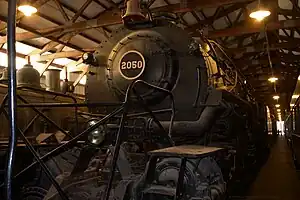Norfolk and Western 2050
Norfolk and Western 2050 is a class "Y3a" 2-8-8-2 Mallet steam locomotive built by the American Locomotive Company (ALCO) at their own Richmond Works for the Norfolk and Western Railway in 1923.[1][2][3]
| Norfolk and Western 2050 | |||||||||||||||||||
|---|---|---|---|---|---|---|---|---|---|---|---|---|---|---|---|---|---|---|---|
 Norfolk and Western 2050 on static display at the Illinois Railway Museum in 2015. | |||||||||||||||||||
| |||||||||||||||||||
| |||||||||||||||||||
| |||||||||||||||||||
| |||||||||||||||||||
History
During World War I, a government agency called the United States Railroad Administration (USRA) took over most of the major railroads. The USRA developed several standard steam locomotive designs, among them a heavy 2-8-8-2 for freight service.[1]
The Norfolk and Western Railway (N&W) liked this design so much that after the USRA had disbanded in 1922, they started building more locomotives to basically the same plan, with minor improvements. N&W had continued to refine the design and they had built the same locomotive design until 1952.[1]
Norfolk and Western 2050 was manufactured in 1923 by the American Locomotive Company (ALCO) at their own Richmond Works and it was the first member of the N&W's Class Y3a numbered 2050-2079 as copies of the USRA 2-8-8-2 locomotives.[1][2] It was built to push heavy coal trains up the mountains.[1]
When diesels locomotives had replaced steam locomotives, 2050 became a stationary boiler at the Armco Steel Plant in Middletown, Ohio. The locomotive sat in storage for 20 years until being purchased in 1975 by the Illinois Railway Museum.[1][3][4] It had eventually arrived at the Illinois Railway Museum in 1976 and was placed on static display at the museum and currently remains there to this day.[1]
References
- "Norfolk & Western 2050". Illinois Railway Museum. Retrieved 2023-10-19.
- Young (2013), p. 18
- Huddleston (2002), p. 86
- Young (2013), p. 172
Further reading
- Young, Jan (2013). Great Railroad Museums of the USA. Lulu.com. ISBN 9781300755555.
- Huddleston, Eugene L. (2002). Uncle Sam's Locomotives - The USRA and the Nation's Railroads. Indiana University Press. ISBN 9780253340863.